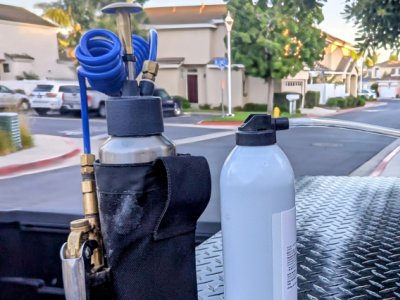Termite Foam vs. Liquid
 When it comes to local treatments for drywood termites, there are three main options: fipronil (in liquid or foam form) and orange oil.
When it comes to local treatments for drywood termites, there are three main options: fipronil (in liquid or foam form) and orange oil.
I’m not a fan of orange oil. It’s a repellent (termites can smell and taste it and simply avoid it), it dissipates in less than a month (so there’s no lasting protection), it only kills on contact (so it can’t be transferred back to the colony), and it’s flammable.
Fipronil, on the other hand, is available in several brand-name termiticides and is my preferred choice. Termites can’t detect it, so they don’t avoid it. It stays active in the wood for up to ten years, offering long-term protection. It doesn’t kill instantly, which means the exposed termites can share it with the colony before dying. And unlike orange oil, it’s not flammable.
Most fipronil-based products come as either a liquid concentrate or a ready-to-use foam. Each has pros and cons:
Foam – Pros
- Pre-mixed and ready to use. The correct chemical ratio is already established.
- Less drilling. Foam expands, so one hole can sometimes reach far. I’ve injected foam in one hole and seen it come out of another six feet away.
- Lightweight. Foam comes in 20oz cylinders—much easier to carry than a heavy spray tank, especially in attics or on ladders.
Foam – Cons
- Hit or miss. If you don’t drill directly into the colony, the foam can just shoot back out of the hole under pressure.
- Not preventative. You can’t reliably treat adjoining wood members, which is best practice.
- Expensive. Like pre-cut groceries, you pay for convenience.
- Requires two hands. Holding the nozzle tight in the drill hole isn’t ideal if you’re on a ladder or crammed in an attic.
Liquid – Pros
- More economical. Less than an ounce of fipronil concentrate treats a gallon of water, and the product lasts.
- Strategic application. You can create “termite traps” by treating around infestations. I often drill downward so the chemical stays in the wood, then seal holes with caulk. Over time, termites run into the treatment and spread it to the colony.
- Better in tough spots. My spray tank needs only one hand to operate. I can stabilize myself with the other, which makes a big difference in attics or on ladders.
Liquid – Cons
- Equipment matters. If all you’ve got is a gallon sprayer, carrying it into attics or up ladders is awkward and unsafe. With a 16oz sprayer, though, this problem disappears.
When I first started, I didn’t even know 16oz sprayers existed. At my last job, I had to drag around a gallon tank everywhere. When I started my own company, one of my first purchases was a small 16oz B&G sprayer—and I’ve never gone back.
I still keep foam canisters in my truck, but honestly, they just sit there. For me, liquid will always be the go-to choice.
John Gelhard


